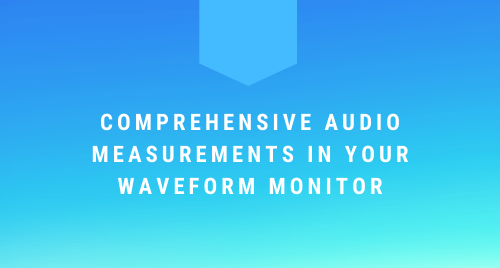By: Steve Bilow, Product Marketing Manager
If you’ve ever tried to set up a home theater system with 5 or 7 speakers and a subwoofer by ear, without a Sound Pressure Level meter, then you know how difficult that is. If you have ever known, for certain, that one of your 2, or 5, or 7 audio channels is out of phase but struggled to find the one place in hundreds of meters of cable where a connection is swapped, then you know that certain judgments are impossible without test equipment. If you’ve ever worried about being fined for exceeding loudness limits in your plant’s audio chain, then you know that relying on subjective assessments can directly impact your profitability.
That’s why audio measurement tools are important, and why including them in the instrument you already use to diagnose video anomalies is the most convenient way to implement them. Here you can see a variety of those tools in that environment.

Example 1: Loudness
Consider objectively assessing loudness compliance. If program amplitudes are inconsistent, the viewer must constantly grab the remote control and, with more than a little frustration, manually adjust the volume. Your transmission chain needs to preserve an acceptable average loudness across all programs. Loudness is a perceptual analog to the physical force of air movement though, and different listeners perceive it differently. You don’t want to rely on one individual’s aural assessment when financial penalties are at stake. That is why we have standards like ITU-R BS.1770 which allow us to measure loudness and peak audio levels quantitatively. Loudness level alarms whose threshold can be set at or near regulatory limits is another way to reduce the risk of compliance violations. When you have this capability built into your waveform monitor, then you can make accurate assessments without a separate instrument. You can validate compliance with the same tool you use to assess video.
Example 2: Surround Sound Analysis
Surround sound is becoming ever more complex. From the early days of quadrophonic recordings to 5.1 audio, to 7.1 audio, and beyond, Surround Sound continues to develop. If overall loudness is subjective, then it’s even more so when you have 7.1 channels to compare. By incorporating a visual Surround Sound display right into your Waveform Monitor, you can monitor the overall balance, or shape, of your surround sound image. You can identify center channel and LFE correlation problems; troubleshoot phase inconsistencies to ensure that the audio downmix will be correctly balanced; and adjust the stereo image width between, not just left and right channels but, each channel pair. None of this can be done without an instrument.
Other Examples
The preceding examples demonstrate why audio instrumentation is critical. As 1080p becomes 4K and that becomes 8K broadcasting, any instrument worth acquiring should offer complete audio support in an IP environment that provides for multiple 2110-30 and 2110-31 compressed Dolby audio streams, Dolby D and E decode with Dolby status support, and the ability to monitor 32 channels of audio for 8K broadcasts out-of-the-box. There is now a way to have that.
An Expanded Audio Application for Maximum Flexibility
The PRISM product family from Telestream includes a complete audio toolset for ST-2110 IP systems and SDI systems that may expand to UHD. The latest software adds significant new support to an already broad range of IP and SDI audio tools. PRISM is a software-defined instrument that permits adding the new audio features with only a software upgrade. You need no special HW no matter which model you have.
System Integrators and Solutions Architects who are designing and building facilities for live- and post-production require comprehensive SDI and IP-based audio monitoring. They now have a single vendor from which to procure instruments that meet every user’s needs. Audio engineers can monitor the quality of, and diagnose anomalies in, multichannel audio content with the same instrument. Engineering and Operations staff in control rooms, Master Control, audio editing and postproduction suites, and their core technical areas, now have all of their needs met in a single instrument.
You will never be able to handle your audio measurement needs with your ears alone, no matter how golden those ears are. You can electronically achieve all of those measurements, though, by adding the right tools to the racks in both production and engineering environments. Select an instrument that does not compromise on the tools you need to offer high quality, compliant, IP and SDI audio measurement and assessment. That choice is possible today.
For more information on how PRISM will meet your audio measurement needs reach out to your systems integrator, contact your Telestream Sales Executive, or visit: http://www.telestream.net/video/prism.htm

